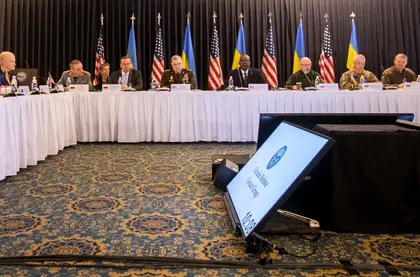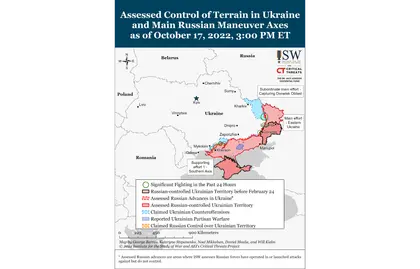Key Takeaways
- Russian forces conducted drone and missiles strikes against residential areas and critical infrastructure facilities throughout Ukraine on October 17.
- Russian drone strikes against residential areas in Kyiv on October 17 are indicative of Russian forces prioritizing psychological terror over tangible battlefield gains.
- Yevgeny Prigozhin and affiliated Telegram channels are increasingly commenting on the ineffectiveness of traditional Russian military institutions, which may be undermining the Kremlin.
- A fratricidal altercation between mobilized servicemen at a training ground in Belgorod Oblast on October 15 is likely a consequence of the Kremlin’s continual reliance on ethnic minority communities to bear the burden of mobilization in the Russian Federation.
- Russia is continuing to leverage its relationship with Iran to obtain drones and missiles, likely to compensate for its increasingly attritted missile arsenal.
- A Russian Su-34 crashed near a residential building in Yeysk, Krasnodar Krai on October 17.
- Russian sources continued to discuss potential Ukrainian counteroffensive operations northwest of Svatove on October 16 and 17.
- Russian sources continued to claim that Ukrainian Forces are conducting counteroffensive operations in Kherson Oblast on October 16 and 17.
- Russian forces conducted ground assaults in Donetsk Oblast on October 16 and 17.
- Ukrainian forces continued to strike Russian concentrations of manpower and equipment in Zaporizhia Oblast on October 16 and 17.
- Russian authorities continued measures to exert full control over the Zaporizhzhia Nuclear Power Plant (ZNPP).
- Moscow City officials announced the completion of partial mobilization in the city on October 17, likely in an effort to subdue criticism among Moscow residents of reports of illegal mobilization in the city.
- Russian and occupation administration officials continue to promote “vacation” programs to residents of Russian-occupied territories likely as pretext for the deportation of Ukrainian citizens and the resettlement of Russian citizens.
Russian forces conducted a series of drone and missile strikes against residential areas and critical infrastructure throughout Ukraine on October 17. Russian troops struck Kyiv, Zaporizhzhia City, and areas in Vinnytsia, Sumy, Dnipropetrovsk, and Mykolaiv Oblasts and launched nine missile strikes and 39 air strikes on October 17.[1] Ukrainian Air Force spokesperson Yuriy Ignat noted that Russian forces launched 43 drones from southern Ukraine, 37 of which Ukrainian troops destroyed and the majority of which were Iranian Shahed-136 drones.[2] Five Shahed-136 drones struck infrastructure in the Shevchenkivskyi district of Kyiv, including the UkrEnergo (Ukrainian electricity transmission system operator) building.[3]
JOIN US ON TELEGRAM
Follow our coverage of the war on the @Kyivpost_official.
The October 17 drone attack on residential infrastructure in Kyiv is consistent with the broader pattern of Russian forces prioritizing creating psychological terror effects on Ukraine over achieving tangible battlefield effects. US military analyst Brett Friedman observed on October 17 that a Shahed-136’s payload is 88 pounds of explosives, whereas a typical 155mm M795 artillery round carries 23.8 pounds of explosives, which means that one Shahed-136 drone carries about three shells worth of explosive material but without the consistent pattern of fragmentation.[4] Friedman suggested that the five Shahed-136s that struck Kyiv had the effect of 15 artillery shells fired at a very large area.[5] Such strikes can do great damage to civilian infrastructure and kill and wound many people without creating meaningful military effects. This analysis suggests that Russian forces are continuing to use Shahed-136 drones to generate the psychological effects associated with targeting civilian areas instead of attempting to generate asymmetric operational effects by striking legitimate military and frontline targets in a concentrated manner.[6]

The Ramstein Format: From Military-Political Cooperation to New Global Security Architecture
A fratricidal altercation between mobilized servicemen at a training ground in Belgorod Oblast on October 15 is likely a consequence of the Kremlin’s continual reliance on ethnic minority communities to bear the burden of mobilization in the Russian Federation. Russian sources reported that the shooting took place after mobilized servicemen from Dagestan, Azerbaijan, and Adyghe complained to their commander that the war in Ukraine is not their war to fight, to which the commander responded that they are fighting a “holy war” and called Allah a “coward,” causing a fight to break out between Muslim and non-Muslim servicemen.[7] Russian sources then claimed that three mobilized Tajik servicemen opened fire at the training ground, killing the commander and both contract and mobilized soldiers.[8] Eyewitnesses claimed that the shooters told Muslim servicemen to stand aside as they opened fire.[9] The Russian information space immediately responded to the incident with racialized rhetoric against Central Asians and called for the introduction of a visa regime in Russia.[10]
Much of the Kremlin’s campaign to avoid general mobilization has fallen along distinct ethnic lines, and ethnic minority enclaves have largely borne the brunt of Russian President Vladimir Putin’s force generation efforts.[11] ISW previously reported on the prevalence of volunteer battalions formed in non-Russian ethnic minority communities, many of which suffered substantial losses upon deployment to Ukraine.[12] This trend continued following Putin’s announcement of partial mobilization, after which authorities continued to deliberately target minority communities to fulfill mobilization orders.[13] ISW also previously noted that the asymmetric distribution of mobilization responsibilities along ethnic lines led to the creation of localized and ethnically based resistance movements, which ISW forecasted could cause domestic ramifications as the war continues.[14] The Belgorod shooting is likely a manifestation of exactly such domestic ramifications. Ethnic minorities that have been targeted and forced into fighting a war defined by Russian imperial goals and shaped by Russian Orthodox nationalism will likely continue to feel alienation, which will create feed-back loops of discontent leading to resistance followed by crackdowns on minority enclaves.
Wagner Group financier Yevheny Prigozhin and Wagner-affiliated social media outlets are increasingly commenting on the ineffectiveness of traditional Russian military institutions and societal issues, which may indirectly undermine the Kremlin’s rule. Prigozhin reiterated that only Wagner troops are operating in the Bakhmut direction, seemingly denying the Donetsk People’s Republic’s (DNR) claims DNR forces are operating in the area.[15] Prigozhin also emphasized that he fully sponsors all of the equipment for his troops when responding to a question about whether the Russian Ministry of Defense (MoD) assists Wagner with supplies. Wagner-affiliated Telegram channels published footage in which elements of the 126th Separate Guards Coastal Defense Brigade of the Black Sea Fleet thanked Wagner for providing them with military equipment.[16] ISW had previously reported that the 126th Coastal Defense Brigade issued a video appeal regarding its lack of military equipment on the Kherson frontline.[17] Prigozhin additionally offered a realistic portrayal of the situation in Bakhmut, noting that Ukrainians are unwilling to surrender. Wagner-affiliated Telegram channels commented on the Belgorod training ground shooting incident, noting that a “quiet civil war” is currently ongoing in Russia due to the Russian government’s long-term inability to restrict migration presumably from Central Asian countries.[18]
Prigozhin’s narratives have the ingredients to appeal to the Russian President Vladimir Putin’s nationalist constituency that has long called for oligarchs to finance supplies for the armed forces, demanded transparency about what is really going on at the front, and criticized Russian higher military institutions for their failures on the frontlines. While Prigozhin does not directly oppose or criticize Putin, his growing notoriety within the nationalist community may undermine Putin’s “strongman” appeal by comparison. The emerging discussions about a civil war in Russia may further disrupt the Kremlin’s narratives about the national, ethnic, and religious unity within Russia.
Russia is continuing to leverage its relationship with Iran to obtain drones and missiles, likely to compensate for its increasingly attritted missile arsenal. The Washington Post reported on October 16 that Iran will likely supply additional missiles, including the Fateh-110 and Zolfaghar short-range ballistic missiles, to Russia in addition to Shahed-136, Mohajer-6, and Arash-2 drones.[19] Iranian Foreign Ministry spokesperson Nasser Kanaani, however, claimed on October 17 that Iran has not provided weapons to “either side,” despite ample reporting by Russian, Iranian, Ukrainian, and Western sources to the contrary.[20] A Russian Telegram channel noted that the recent Russian use of Iranian munitions, particularly the Shahed-136s, is likely reflective of the fact that Russia has nearly exhausted most of its domestic stock of operational-tactical weapons.[21] The channel claimed that Shahed-136s fulfil the role of cruise missiles but allow Russia to circumvent sanctions while maintaining its ability to conduct deep operational strikes.[22]
A Russian Su-34 crashed near an apartment building in Yeysk, Krasnodar Krai on October 17. Russian sources claimed that the Su-34 crashed due to an issue with one of its engines.[23] The Su-34 crashed carrying ammunition that detonated on impact causing a fire that engulfed the nearby apartment building.[24] A Russian source claimed that the crash killed one person and seriously injured three others.[25]
Authors: Karolina Hird, Kateryna Stepanenko, Riley Bailey, and Frederick W. Kagan
See the full report here.
You can also highlight the text and press Ctrl + Enter






